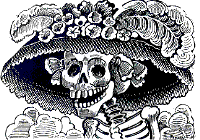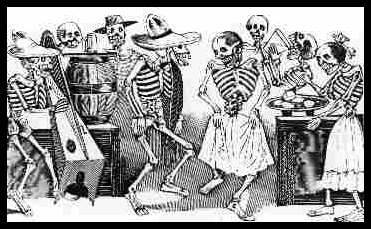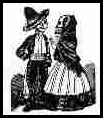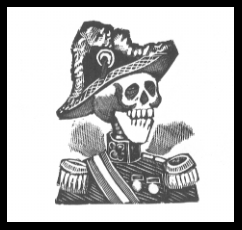

Many who have visited the Mexican pavilion in the World Showcase at Epcot may have noticed a section featuring one of Mexico's most interesting, some consider it the most important holiday, The Day of the Dead, when families honor the dead with feasting and parades. Much of the art of Mexican crafters is based on the icons of this holiday; mainly skulls and skeletons.
La Calavera, a fashionable lady portrayed as a skeleton, is representative of the genre. The artist, Jose Guadalupe Posada (1852-1913), was a political cartoonist and folk artist whose illustrations have become synonymous with the Day of the Dead. Calavera means skull; it also refers to the practice of writing witty epitaphs for living people. Posada became the master of the calavera, portraying many political and professional people of his day and accompanying his drawings with humorous verses.
Here are a few more Posada pieces:
 |  |
 |  |  |
Why do skeletons feature so heavily on this holiday? It may seem to some that skeletons are icons of death, and one may consider it macabre that these icons are shown in everyday circumstances mimicking activities of live people. There is a very interesting explanation of the grinning skulls and dancing skeletons at: The Days Of The Dead. Here are a couple of excerpts from Vera Cala's very informative site.
 "Day of the Dead, or el Día de los Muertos, is a happy celebration in Mexico. That's when the souls of the dearly departed return home to the world of the living. All of them. From Heaven, Hell and Purgatory, they descend upon their families and for two days, November 1 and 2, they rejoice together. ...In the Latino culture, The Dead are full of Life. We see it in the statues, toys and trinkets of el Día De Los Muertos. Miniature skeletons sporting mohawks and big grins play in rock bands.
"Day of the Dead, or el Día de los Muertos, is a happy celebration in Mexico. That's when the souls of the dearly departed return home to the world of the living. All of them. From Heaven, Hell and Purgatory, they descend upon their families and for two days, November 1 and 2, they rejoice together. ...In the Latino culture, The Dead are full of Life. We see it in the statues, toys and trinkets of el Día De Los Muertos. Miniature skeletons sporting mohawks and big grins play in rock bands.  Paper mache skulls bear pink flowers for eyes and green lizards on their brows. Wooden skeletons on rods dance wildly, with arms and legs flailing, whenever you pull their strings. The calaveras sing, dance, laugh - they even ride on merry-go-rounds and drive rickety wooden trucks. And of course, they drink pulque, (a fermented drink made from cactus)."
Paper mache skulls bear pink flowers for eyes and green lizards on their brows. Wooden skeletons on rods dance wildly, with arms and legs flailing, whenever you pull their strings. The calaveras sing, dance, laugh - they even ride on merry-go-rounds and drive rickety wooden trucks. And of course, they drink pulque, (a fermented drink made from cactus)."
The skeletons, made of paper mache, ceramic, wood or tin, have become highly collectible items, especially in the United States. Being a collector myself, I find these pieces sometimes very hard to find, and in certain areas, very expensive. Part of the fun of going to any new city is prowling around to find the little shops that might carry them.
Some of the smaller and less rare pieces are comparatively inexpensive, fortunately, and there are enterprising merchants who have put them on t-shirts and cups, which are also inexpensive. Most of the art that's depicted on this page, especially La Calavera and the Dance, are part of a whole line of t-shirts devoted to the art of José Posada. These are fun to find also (and go well with everything from shorts to tuxedos).
 |
 Left-click to view at twice this size This is a market stall in Mexico where models of coffins, skulls, crosses and skeletons are sold. |
 |
 an integral part of the decorating done for the family altars, which are also adorned with flowers and myriads of candles in order to welcome back the dead on that night. Most families spend the day either picknicking at the cemetery where their relatives are buried, or at home where they have set up the altars. Some altars are very simple; some, like the illustration at left, are very elaborately decorated. Along with pictures of the deceased, candy, traditional and favorite dishes like cheese soup with corn bread, chili, or a special bread called pan de muerto (bread of the dead) are also set out. During Day of the Dead, the families pray to the souls of their dead relatives, hoping that they will return to the land of the living for that one night. Optimistically, they sometimes even place soap and water so the relatives can freshen up after their long trip back.
an integral part of the decorating done for the family altars, which are also adorned with flowers and myriads of candles in order to welcome back the dead on that night. Most families spend the day either picknicking at the cemetery where their relatives are buried, or at home where they have set up the altars. Some altars are very simple; some, like the illustration at left, are very elaborately decorated. Along with pictures of the deceased, candy, traditional and favorite dishes like cheese soup with corn bread, chili, or a special bread called pan de muerto (bread of the dead) are also set out. During Day of the Dead, the families pray to the souls of their dead relatives, hoping that they will return to the land of the living for that one night. Optimistically, they sometimes even place soap and water so the relatives can freshen up after their long trip back.To learn even more about the Day of the Dead customs, or to view more art, try the following links:
| Halloween Back to Halloween index |
RaggBagg To RaggBagg Realm index |
This site was last updated February 2, 2003.
Previous nedstat counter 2619
Market Stall picture and the two sugar skulls as well as some of the textual information
is from a book called "Celebrations," part of a children's series of books sponsored by Unicef.
The authors are Barnabas and Anabel Kindersley.